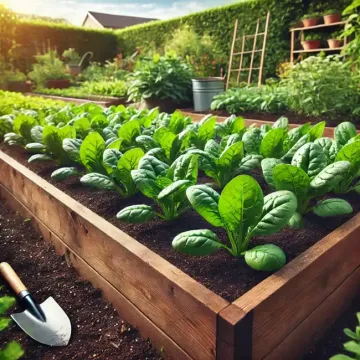Spinach is a versatile, nutrient-rich leafy green that thrives in both cool and warm seasons. It’s popular among home gardeners due to its ease of growth and adaptability. Whether you are a novice or an experienced gardener, spinach is a rewarding crop that can be grown in various climates. This article will cover spinach varieties suitable for different seasons and provide tips on harvesting methods, including the "cut and come again" technique.
Varieties for Cool Season vs. Warm Season
Spinach is generally considered a cool-season crop, but certain varieties are better suited to specific temperature ranges. Here's a breakdown of the best spinach varieties for cool and warm seasons:
Cool Season Varieties
Cool-season varieties of spinach thrive in temperatures ranging from 35°F to 75°F. These varieties tend to bolt (go to seed) when exposed to prolonged warm temperatures, so they are ideal for planting in early spring or fall. Some popular cool-season varieties include:
- Bloomsdale Long Standing: This heirloom variety is known for its deep green, crinkled leaves and resistance to bolting. It's perfect for early spring or fall planting.
- Tyee: A semi-savoy (slightly crinkled) variety that offers good resistance to downy mildew and has a slower bolting tendency, making it an excellent choice for cooler temperatures.
- Space: A smooth-leafed variety that matures quickly and offers tender leaves. It performs well in the cooler months of spring and fall.
Warm Season Varieties
For those looking to extend the spinach-growing season into warmer months, certain heat-resistant varieties are available. These varieties are bred to withstand higher temperatures without bolting as quickly. Here are a few warm-season varieties:
- New Zealand Spinach: Technically not a true spinach but a close relative, this variety thrives in warm weather. It produces lush, tender leaves throughout the summer.
- Malabar Spinach: Another heat-tolerant alternative, this vining plant loves the heat and can be harvested similarly to traditional spinach.
- Correnta: This variety is slow to bolt and can withstand warmer temperatures better than most traditional spinach types.
Planting and Care Tips
Spinach prefers well-drained soil rich in organic matter with a neutral to slightly acidic pH (6.0 to 7.0). It's best to sow seeds directly into the garden, as spinach doesn't transplant well. Ensure the seeds are planted about ½ inch deep and spaced 1 inch apart. Once the seedlings are established, thin them to allow about 3 to 4 inches between plants.
Regular watering is crucial, especially during dry spells, as spinach prefers consistent moisture. Mulching around the plants helps retain soil moisture and suppress weeds.
For continuous harvest, consider planting successive crops every two weeks, especially in the early spring and fall, to keep fresh spinach on your table throughout the growing season.
Harvesting Methods
Spinach can be harvested at various stages of growth, depending on your preferences and needs. Here are a few common harvesting methods:
Cut-and-Come-Again
The "cut-and-come-again" method is ideal for those who want a prolonged harvest. In this technique, you selectively harvest the outer leaves while leaving the inner leaves to continue growing. This method allows the plant to regenerate new growth, providing multiple harvests from the same plant over several weeks.
To use this method:
- Wait until the spinach plant has at least 6 to 8 leaves.
- Use scissors or a sharp knife to cut the outer leaves about an inch above the base of the plant.
- Be careful not to damage the inner leaves or the growing point, as this will allow the plant to continue producing.
Full Plant Harvest
If you prefer to harvest the entire plant at once, wait until the spinach has matured and developed a full rosette of leaves. This method is typically used for late-season crops or when preparing the garden for the next planting.
- Grasp the plant at the base and pull it up by the roots.
- You can also cut the plant at the base, just above the soil line, using a sharp knife or scissors.
Full plant harvesting is best done before the plant begins to bolt. Once spinach bolts, the leaves turn bitter and are less palatable.
Conclusion
Spinach is an easy-to-grow leafy green that offers flexibility in both planting and harvesting. By selecting the right varieties for your climate and employing appropriate harvesting techniques, you can enjoy a continuous supply of fresh spinach throughout the growing season. Whether you choose the cool-season or warm-season varieties, the cut-and-come-again method, or full plant harvest, spinach will be a nutritious and productive addition to your home garden.

